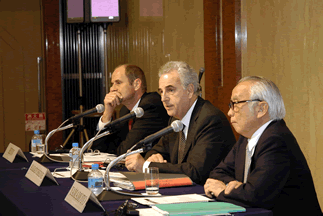Five years since its establishment, the Global Fund to Fight AIDS, Tuberculosis and Malaria (the Global Fund) has successfully raised billions of dollars and made impressive strides in the fight against the world’s major communicable diseases. But, without an even deeper commitment from around the globe, the impact cannot be sustained. This is where Japan’s leadership role has become critical, particularly in the lead up to two major summits being held in Japan in 2008— the Group of Eight (G8) Summit in Toyako, Hokkaido, and the Fourth Tokyo International Conference on African Development (TICAD IV).
The Japan Center for International Exchange (JCIE) / Friends of the Global Fund, Japan (FGFJ), held a seminar in Tokyo on July 26, on the topic “From Heiligendamm to Toyako—The Global Fund on the G8 Agenda,” during which Dr. Michel Kazatchkine, executive director of the Global Fund, and Dr. Christoph Benn, the Global Fund’s director of external relations, offered the audience an overview of the Global Fund’s work and its results so far and appealed to Japan to make sure that the momentum that started in Okinawa eight years ago is not lost over the coming years.
Dr. Kazatchkine opened the seminar with praise for Japan’s role in the establishment of the Global Fund, tracing its roots back to the 2000 Kyushu-Okinawa G8 Summit—the last time a G8 Summit was held in Japan—when “for the first time the burden of infectious disease was discussed as a major impediment to economic and social development and where international targets for [reducing] this burden were set.” The world leaders who took part in the summit and other meetings surrounding it set a precedent by expressing their “conviction that investing in heath is a moral, as well as an economic, imperative.” At the same time, health is a results-oriented and measurable field that is also humanistic, making it a natural cause for leaders of G8 countries to rally around. As such, the Global Fund now receives 80 percent of its resources from G8 countries.
By July 2007, the Global Fund had raised US$11 billion, US$7.7 billion of which has been committed to 450 programs in 136 countries around the world. More than US$1.6 billion of the funds has been invested in programs in Asia, a region that is beginning to see a “blurring in the conventional distinction between ‘donor’ and ‘recipient’ countries” as several recipient countries—China, India, and Thailand—have begun to make their own financial commitments to the Global Fund.
The G8 Summit and other meetings in Okinawa also set the stage for innovative thinking on collaboration and partnership by bringing corporations, civil society organizations, and international agencies into the dialogue. While the vast majority of funding for the Global Fund comes from governments, it also receives financial and in-kind support from the private sector, both from foundations and corporations. The RED campaign is one of the most visible forms of corporate support for the Global Fund today, but many other companies have lent their support by helping implement grants, making co-investments with the Global Fund, and providing management and oversight support, to name just a few methods of engagement.
An evaluation of the Global Fund’s first five years of activities indicates that 2 million lives had been saved by the fund as of the time of the seminar, and that number, which does not include the number of people who escaped infection because of the Global Fund’s prevention activities, is expected to climb above 3 million by the time the next G8 Summit is held in Japan in July 2008. Through its programs, 1.1 million people in the developing world have begun receiving life-saving antiretroviral (ARV) treatment, 2.8 million people have been treated for tuberculosis, and 30 million bed nets have been distributed to families so that they can protect their children from mosquito bites in malaria-prone areas.
In addition to these visible impacts, Dr. Benn noted that the unique Global Fund experience might offer lessons beyond the fight against communicable diseases and enrich G8 discussions in other fields as well. One example is the fund’s decision-making process, which ensures that all parties represented in the board of directors—governments, the private sector, civil society, UN agencies—have equal voting rights with no party able to dominate the others. It also divides votes into two groups—one representing public and private donors and the other representing NGOs and communities living with the diseases—and both groups need to agree on any decisions that are made.
For more information on this event, please visit the FGFJ website.



